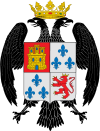Montalbán de Córdoba
| Montalbán de Córdoba | |||
|---|---|---|---|
| Municipality | |||
|
|||
| Location in Spain | |||
| Coordinates: 37°35′N 4°45′W / 37.583°N 4.750°WCoordinates: 37°35′N 4°45′W / 37.583°N 4.750°W | |||
| Country |
|
||
| Autonomous community |
|
||
| Province | Córdoba | ||
| Comarca | Campiña Sur | ||
| Judicial district | Montilla | ||
| Government | |||
| • Alcalde | Miguel Ruz Salces (2011) (IU) | ||
| Area | |||
| • Total | 33.66 km2 (13.00 sq mi) | ||
| Elevation | 273 m (896 ft) | ||
| Highest elevation | 349 m (1,145 ft) | ||
| Population (2011) | |||
| • Total | 4,586 | ||
| • Density | 140/km2 (350/sq mi) | ||
| Demonym(s) | Montalbeño /-a | ||
| Time zone | CET (UTC+1) | ||
| • Summer (DST) | CEST (UTC+2) | ||
| Postal code | 14548 | ||
| Dialing code | (+34) 957 31X XXX | ||
| Patron Saint | Francis of Assisi | ||
| Website | www |
||
Montalbán de Córdoba is a town in the province of Córdoba in Andalusia, southern Spain. The town is 42 km from Córdoba, the capital of the province.
El Calvario is in the south part of Montalbán, inside the town limits. The original Calvario hermitage, built during the first half of the 17th century, was a small church on the outskirts of Montalbán, near the old castle ruins. The building construction used poor quality material and it was soon found to be in a state of near ruin. Construction of a new chapel at the site of the first began in 1773 and was completed in 1776. This chapel, though stronger than the previous one, unfortunately was also built with inferior materials, so that, at the end of March 1852, the lantern and the dome of the chapel collapsed.
After consultation with competent builders, the second Chapel was torn down and rebuilt from the ground at its new location in town. The work was completed in July 1856, and the image of Nuestro Padre Jesús del Calvario was returned to the new chapel on August 25, upon which the village celebrated with the ringing of bells, illuminations, temporary triumphal arches, and buntings hung on edifices. The building is decorated in Neoclassical style; its exterior is rather plainly finished in white stucco, while the dome and roof lantern cupola are tiled. The church is consecrated to Nuestro Padre Jesús del Calvario (Our Father Jesus of Calvary); his image is in the altarpiece, which is worked in the Sevillian style. The building's ground plan is cruciform, in the shape of a Greek cross.
The archway by the artist Francisco Suarez was preserved in the chapel. The guesthouse was built in 1866 in order to accommodate pilgrims who arrived daily in fulfillment of their sacred vows.
In the same year the House of the Santeros (image-carvers) was raised with the fencing and arched gates of the entrance court. The dedication of the new chapel was given by Major Master Ecija, D. Corrales Jose Martinez, who explained its relationship to the architecture of Seville.
...
Wikipedia



